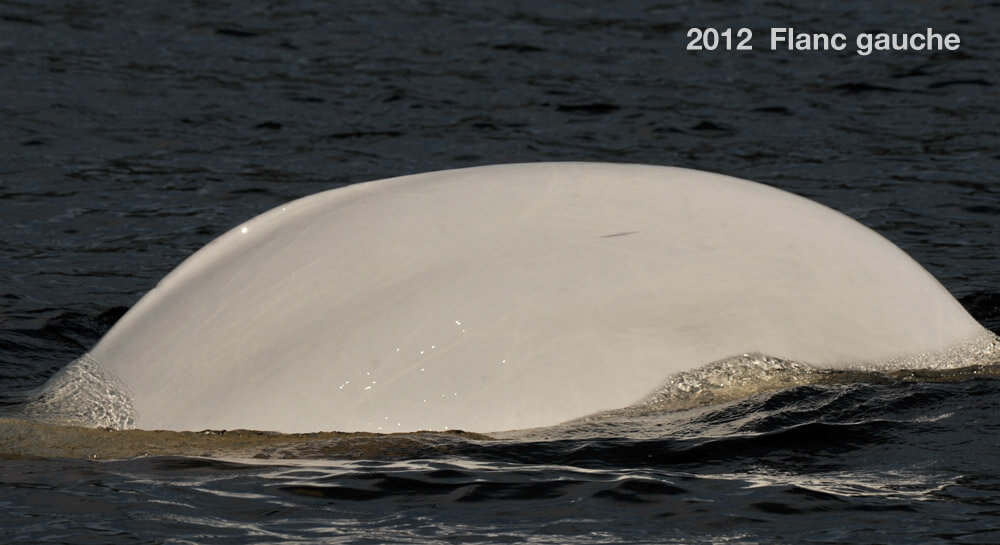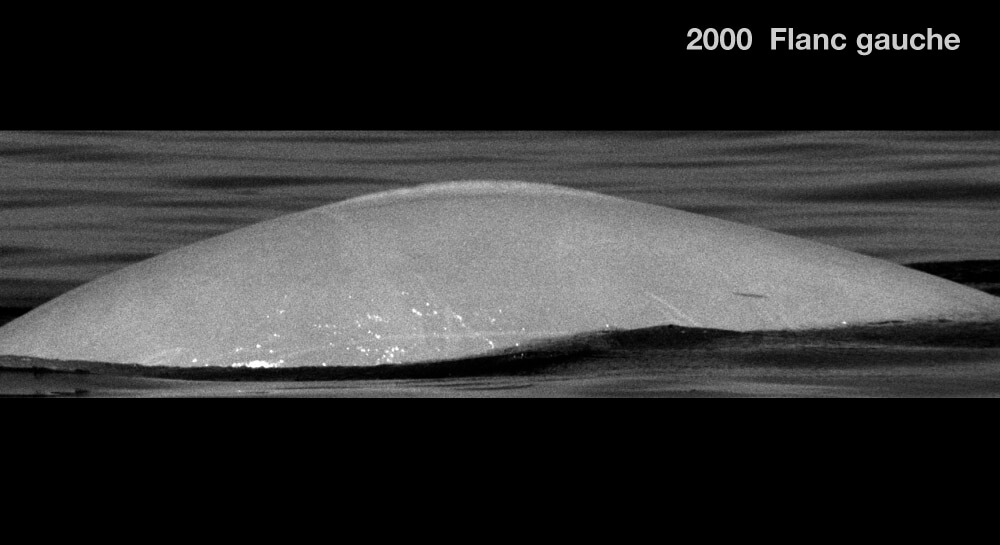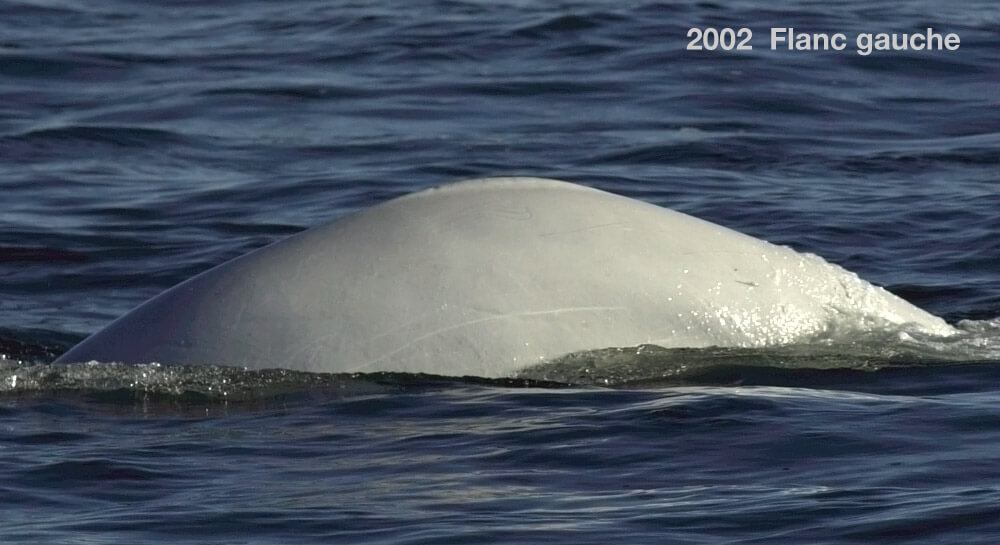Pure Laine
Beluga


Adopted by Cynthia Fish
-
ID number
DL1628
-
Sex
Presumed female
-
Year of birth
Around 1985
-
Known Since
2000
Distinctive traits
Were it not for the small gray line on her left peduncle combined with the small gash in her dorsal crest, Pure Laine would be indistinguishable from other belugas.
Life history
Our first encounter with Pure Laine goes back to the summer of 2000. She was slightly grayish in colour at the time. Belugas fade from gray to white in colour between the ages of 12 and 16. Pure Laine would therefore have been born around 1985 or earlier.
Even if no biopsy has been performed, her size, habits and regular presence in herds comprising adults and young suggest that Pure Laine is a female belonging to the Saguenay community. In their summer range, females form large communities in which they tend to newborns and young. These communities are associated with traditional territories. Pure Laine is first observed with a calf in 2002. The observation is a brief one and Pure Laine is not seen again for the remainder of the season. The team is unable to confirm whether or not the newborn was her own.
Pure Laine is regularly seen in the company of DL0030, Slash and Miss Frontenac, all of whom are also females from the Saguenay community. Associations between females of the same community are generally not very stable. They may vary depending on the females’ reproductive status and whether or not they are pregnant or accompanied by a calf.
How Pure Laine’s story unfolds will help us better understand the social and reproductive lives of belugas. By better understanding how belugas live, we will better be able to protect them.
Observations history in the Estuary
Years in which the animal was not observed Years in which the animal was observed
Latest news
The sun is shining brightly in the early afternoon. From the land-based observation site at Pointe-Noire, we follow a group of around 50 belugas, who have come to spend part of the day at the mouth of the fjord, where the waters of the Saguenay meet the St. Lawrence. All around us, white backs are catching the sun as they burst through the surface. The group is spread out and quite heterogeneous: there are many adults, but also pairs made up of adults and young grey belugas. Pure Laine, this year, is not accompanied by a calf, but we count three or four in the group she frequents. During a calm phase of logging, one of these calves dives and emerges several times along its mother’s right flank. Perhaps it was suckling its mother? Nursing is quite difficult to observe from the boat. The height of the Pointe-Noire platform gives us a privileged, almost aerial view, without disturbing the belugas!
Special day aboard the Bleuvet… Our research boat is host to guest researcher Valeria Vergara from the organization Ocean Wise, who has collaborated with the GREMM every summer since 2015. The team is also accompanied by a film crew that is putting together a documentary on beluga research. To kick off the day, we enter the Saguenay River. In the distance, we spot a herd of 30 to 40 individuals coming out of Baie Sainte-Marguerite. On the other side of the river, near Anse Saint-Etienne, there is another herd of 40 to 60 belugas. We photograph the groups before taking out the drone. By the time we’re ready to launch, the belugas are gone. We spot a new group. While photographing the animals and flying over them with the drone to document their behaviour, we recognize Marjo and Pure Laine. Meanwhile, Valeria records underwater communication using a hydrophone. Will we be able to recognize your beluga in our videos and sound recordings?
Aboard the GREMM’s research vessel Bleuvet, we make our way toward Îlet aux Alouettes off the coast of Baie-Sainte-Catherine and Pointe Noire. We encounter a herd of 30 belugas consisting of adults, grays and a newborn. Within the herd we recognize Pure Laine, who is swimming together with DL2377, a beluga that has only ever been photographed once, way back in 2005! Alongside DL2377 is a newborn. Is it hers? Only multiple other observations or a biopsy of both animals would allow us to confirm their relationship, or lack thereof. The more we observe these belugas, the more we get the sense that they are swimming in every direction. This type of behaviour leads us to believe that they are feeding. We decide to let them eat in peace and head up the Saguenay to look for other herds.
Summer 2016, our 32nd season at sea with the belugas, was again rich in encounters and surprises. We saw Pure Laine on at least five occasions. In 2015, she had been observed with newborn calves, but we couldn’t confirm that she was the mother. This year, during the various encounters with the team, she was always accompanied by a newborn. These observations lead us to believe that she gave birth in 2015.
On September 16, 2016, we observed Pure Laine in the Saguenay Fjord, between anse à la Barque and cap de la Boule. She swims among a herd of 40 belugas heading for the mouth of the fjord. Within the herd, there are some all-white individuals – including the well-known females Blanche, Miss Frontenac and Athéna – but 70% of the belugas are gray or slightly gray. It’s a herd of adults, but mostly youngs. Two newborns have also been observed. The Saguenay is a place where the sexes and generations of belugas intermingle in summer : networks of males intermingle with communities of females, such as Pure Laine, and juveniles, as well as groups of young males, the “teens”.
We are sailing in the Saguenay Fjord. Pure Laine is in a herd of around ten individuals, including adults and juveniles. Among a group of two adults and two juveniles, Pure Laine can be seen swimming with Yogi, an old female from the Saguenay community, and two young belugas, still gray. The whole herd is in tight formation. The belugas swim against each other and head upstream. As the wind picks up and becomes very strong, we have to leave the herd to seek shelter.
This summer, we met Pure Laine five times. On several of these occasions, Pure Laine was seen in the proximity of newborn babies. However, our observations were unable to confirm that one of the babies was actually hers! Here’s the story of one of these encounters.
On August 28, 2015, we were sailing in the mouth of the Saguenay near the Pointe-Noire observation site. We’re not the only ones keeping a close eye on the herd that includes Pure Laine ; visitors to the site are also scrutinizing the animals’ movements from the heights of the lookout. The dozen or so individuals, females accompanied by young belugas, circle, dive and resurface in the same spot several times. We suspect they’re feeding. There’s a certain amount of excitement aboard the boat, as this week we begin a brand-new project on the sounds of newborn beluga whales. We’re recording the herd, but the belugas are mute! But that’s just the beginning!
This is a contact rich in newborns! We’re at the mouth of the Saguenay, just a few meters from our home port of Tadoussac. Between Pointe Rouge and Pointe Noire, we observe five newborns, including Marguerite, Miss Frontenac and Blanche. Pure Laine swims alongside them. So far, we’ve never been able to confirm that Pure Laine is fertile. Will we see her with a calf soon? We leave the belugas with newborns alone, and go to a group of adults to take two biopsies.
Sponsor
Cynthia Fish adopted Pure Laine (2014).


